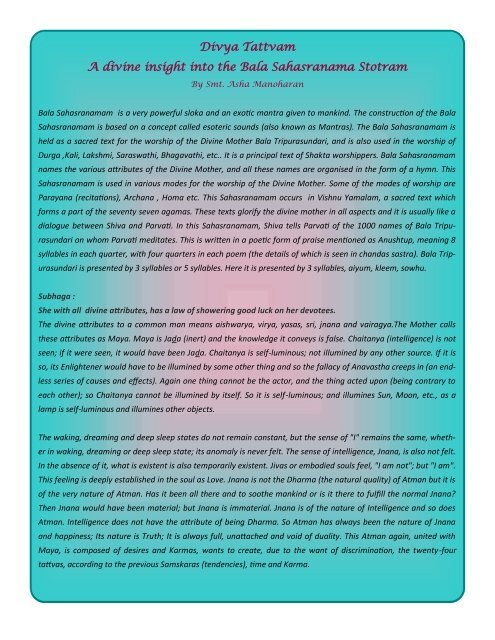Balavin Kural
Balavin Kural
Balavin Kural
You also want an ePaper? Increase the reach of your titles
YUMPU automatically turns print PDFs into web optimized ePapers that Google loves.
Divya Tattvam<br />
A divine insight into the Bala Sahasranama Stotram<br />
By Smt. Asha Manoharan<br />
Bala Sahasranamam is a very powerful sloka and an exotic mantra given to mankind. The construction of the Bala<br />
Sahasranamam is based on a concept called esoteric sounds (also known as Mantras). The Bala Sahasranamam is<br />
held as a sacred text for the worship of the Divine Mother Bala Tripurasundari, and is also used in the worship of<br />
Durga ,Kali, Lakshmi, Saraswathi, Bhagavathi, etc.. It is a principal text of Shakta worshippers. Bala Sahasranamam<br />
names the various attributes of the Divine Mother, and all these names are organised in the form of a hymn. This<br />
Sahasranamam is used in various modes for the worship of the Divine Mother. Some of the modes of worship are<br />
Parayana (recitations), Archana , Homa etc. This Sahasranamam occurs in Vishnu Yamalam, a sacred text which<br />
forms a part of the seventy seven agamas. These texts glorify the divine mother in all aspects and it is usually like a<br />
dialogue between Shiva and Parvati. In this Sahasranamam, Shiva tells Parvati of the 1000 names of Bala Tripu-<br />
rasundari on whom Parvati meditates. This is written in a poetic form of praise mentioned as Anushtup, meaning 8<br />
syllables in each quarter, with four quarters in each poem (the details of which is seen in chandas sastra). Bala Trip-<br />
urasundari is presented by 3 syllables or 5 syllables. Here it is presented by 3 syllables, aiyum, kleem, sowhu.<br />
Subhaga :<br />
She with all divine attributes, has a law of showering good luck on her devotees.<br />
The divine attributes to a common man means aishwarya, virya, yasas, sri, jnana and vairagya.The Mother calls<br />
these attributes as Maya. Maya is Jada (inert) and the knowledge it conveys is false. Chaitanya (intelligence) is not<br />
seen; if it were seen, it would have been Jada. Chaitanya is self-luminous; not illumined by any other source. If it is<br />
so, its Enlightener would have to be illumined by some other thing and so the fallacy of Anavastha creeps in (an end-<br />
less series of causes and effects). Again one thing cannot be the actor, and the thing acted upon (being contrary to<br />
each other); so Chaitanya cannot be illumined by itself. So it is self-luminous; and illumines Sun, Moon, etc., as a<br />
lamp is self-luminous and illumines other objects.<br />
The waking, dreaming and deep sleep states do not remain constant, but the sense of "I" remains the same, wheth-<br />
er in waking, dreaming or deep sleep state; its anomaly is never felt. The sense of intelligence, Jnana, is also not felt.<br />
In the absence of it, what is existent is also temporarily existent. Jivas or embodied souls feel, "I am not"; but "I am".<br />
This feeling is deeply established in the soul as Love. Jnana is not the Dharma (the natural quality) of Atman but it is<br />
of the very nature of Atman. Has it been all there and to soothe mankind or is it there to fulfill the normal Jnana?<br />
Then Jnana would have been material; but Jnana is immaterial. Jnana is of the nature of Intelligence and so does<br />
Atman. Intelligence does not have the attribute of being Dharma. So Atman has always been the nature of Jnana<br />
and happiness; Its nature is Truth; It is always full, unattached and void of duality. This Atman again, united with<br />
Maya, is composed of desires and Karmas, wants to create, due to the want of discrimination, the twenty-four<br />
tattvas, according to the previous Samskaras (tendencies), time and Karma.


